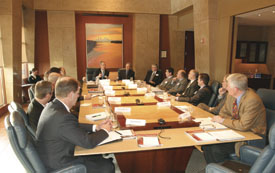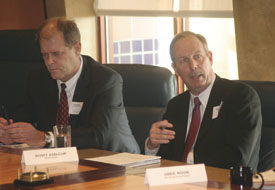
Patrick Pribyl, who oversees the surety practice at Lockton, defined Las Vegas as the quintessential boom town but described Kansas City as “a growing, dynamic city, which is wonderful.” He noted that each year the city has had some major project under construction, a Sprint campus or a Kansas Speedway for instance. “We seem to be hitting doubles and triples and home runs,” said Pribyl in a baseball metaphor less and less heard in these parts, “as opposed to just singles all the time.”
“Looking Downtown and seeing all that activity in a small area gets the perception of a gigantic boom,” argued Ramin Cherafat of McCownGordon Construction. Cherafat, however, believes that there’s enough unexploited potential beyond the central core of the metropolitan area to make “boom” questionable.
Greg Nook of J.E. Dunn Construction believes that we’re in a growth cycle that will last for some period of time, periodic “ups and downs” notwithstanding. He cited prognosticators who believe that a period of steady growth can be sustained nationally for the next 15 to 25 years.
As to local projects of note, Dennis Thompson of Walton Construction believes that local growth will be dependent upon referendums and public funding. “I think we’re ready to respond as companies,” he added. Thompson was asked for a useful term somewhat short of boom. Said he wryly, “Solid business plan.”
 Scott Stalcup comments on variables in the construction industry, such as oil and steel shortages. Dan Morgan listens in.
Scott Stalcup comments on variables in the construction industry, such as oil and steel shortages. Dan Morgan listens in.
Rising Costs
Given the at least relative boom in local building, or the “solid business plan” as the case may be, participants were asked to describe the most immediate challenge threatening its sustainability.
“The number one problem is always finding new clients,” said Jim Calcara of 360 Architecture. This problem, of course, is perennial. More specifically, Calcara cited the escalating costs of construction and the impact such cost surges are having on clients.
“The sticker shock is shocking,” said Calcara, only half joking. Scott Stalcup with Gould Evans added detail, citing the rise in the interest rates as well as the rise in the construction costs coupled with a slow growth in lease rates. This has made it difficult to keep up with actual hard costs. For Gould Evans, as a result, “The pressure on us to perform at a lower entry cost has become greater over the last two years.”
From a “developer’s perspective,” John Foudray with MC Lioness Realty Group agreed that “costs are going up but lease rates aren’t.” The net result, as he sees it, is that “incentives are going to play a big role in new development in Kansas City.”
For Greg Nook the impact of “outside influences” on costs was a critical variable. Here he cited oil shortages and attempts to corner the steel market as variables “having an impact on our ability to do work in the U.S.” How we respond to these issues, said Nook, “is going to be a challenge for the future.”
Dan Morgan of the Builders’ Association and the Kansas City chapter of ADC observed that material prices experienced double-digit inflation and for some materials the prices went up some 40 or 50 percent. Katrina caused a variety of price increases as well.
As Jack Nix observed, shortages caused as much difficulty as cost increases, a by-product of the same. “We couldn’t get cement in Denver and Albuquerque,” said Nix, citing just one example. “Just could not get it.” Shortages cause a particular problem with owners who insist on a quick turn around.